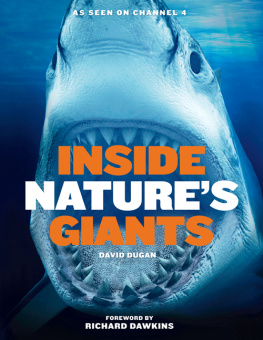Natures Compass
Books in the SCIENCE ESSENTIALS series bring cutting-edge science to a general audience. The series provides the foundation for a better understanding of the scientific and technical advances changing our world. In each volume, a prominent scientistchosen by an advisory board of National Academy of Science membersconveys in clear prose the fundamental knowledge underlying a rapidly evolving field of scientific endeavor.
The Great Brain Debate: Nature or Nurture,
by John Dowling
Memory: The Key to Consciousness,
by Richard F. Thompson and Stephen Madigan
The Faces of Terrorism: Social and Psychological Dimensions,
by Neil J. Smelser
The Mystery of the Missing Antimatter,
by Helen R. Quinn and Yossi Nir
The Long Thaw: How Humans Are Changing the Next 100,000 Years of Earths
Climate, by David Archer
The Medea Hypothesis: Is Life on Earth Ultimately Self-Destructive?
by Peter Ward
How to Find a Habitable Planet,
by James Kasting
The Little Book of String Theory,
by Steven S. Gubser
Enhancing Evolution: The Ethical Case for Making Better People,
by John Harris
Natures Compass: The Mystery of Animal Navigation,
by James L. Gould and Carol Grant Gould
Natures Compass
The Mystery of Animal Navigation

James L. Gould
Carol Grant Gould

Copyright 2012 by Princeton University Press
Published by Princeton University Press, 41 William Street, Princeton, New Jersey 08540
In the United Kingdom: Princeton University Press, 6 Oxford Street, Woodstock, Oxfordshire OX20 1TW
Jacket photograph: Canadian geese migration in sunset, Alaska Stock Images/National Geographic Stock
press.princeton.edu
All Rights Reserved
Library of Congress Cataloging-in-Publication Data
Gould, James L., 1945
Natures compass : the mystery of animal navigation / James L. Gould, Carol Grant Gould.
p. cm.(Science essentials)
Includes bibliographical references and index.
ISBN 978-0-691-14045-2 (hardback : alk. paper) 1. Animal navigation. I. Gould, Carol Grant. II. Title.
QL782.G68 2012
591.568dc23 2011035086
British Library Cataloging-in-Publication Data is available
This book has been composed in in Minion and Myriad
Printed on acid-free paper.
Printed in the United States of America
10 9 8 7 6 5 4 3 2 1
For Verity,
whose loft may be found at
420654.72N
710643.59W
Contents
Preface
... and they spend their winters upon the moon.
This was the deduction of the person of learning and piety who published a treatise in 1703 on
the probable solution of this question: whence come the stork and the turtle, and the crane and the swallow, when they know and observe the appointed time of their comingor where those birds do probably make their recess and abode, which are absent from our climate at some certain times and seasons of the year?
The idea that migrants might overwinter on the moon may have fallen out of fashion, but not our sense of awe at the seemingly effortless way many animals come and go as they choose. Migrating animals have always been a mystery, appearing unexpectedly and vanishing again, en route from an unidentified home to an unknown destinationa living allegory of human existence. As the eighth-century scholar and historian the Venerable Bede (731) wrote in his Ecclesiastical History of the English People, The life of man is but a moment of existence.
Consider the swift flight of a sparrow through the room in which we sit at supper in winter, while darkness and a snowstorm prevail outside. The sparrow, flying in at one open window and immediately out at another, vanishes from our sight after experiencing a few seconds of warmth and light. So too the life of man is but a brief moment; of what went before, or what is to follow, we are utterly ignorant.
Some of that age-old sense of mystery remains, but our increasing knowledge has only served to deepen our awe at the phenomenon of migration. How incredible, that the tiny hummingbirds at our feeders have journeyed north 1500 miles for the brief summer, while fragile monarch butterflies are preparing themselves for a 2000-mile trip south in the fall. And yet, for them and myriad other species, it is perfectly routine. Most animals for which even local navigation is a common and crucial activity are performing feats far beyond anything humans can manage without specialized instruments, equipment, and training. What they know innately about the sun and sky could fill volumes. The still more remarkable ability of many species to deduce their global position to within about a mile is, for all we knew to the contrary even just a few years ago, magic.
There is no one answer to the mysteries of animal navigation. Orientation and migration are conundrums that have been only haltingly solved. The challenge has been difficult because mechanisms vary not only between species, but within the same animal in different contexts and at different ages. Creatures are using the sun and stars, polarized light and color gradients, endogenous timers (daily, tidal, lunar, and annual), landmark memory and cognitive maps, magnetic fields, extrapolated gradients, and more. They confound study by using cues redundantly, so that if we remove one source of information they simply switch to a backup, making a shambles of our attempts to understand their abilities. For some, their navigation system is an integral part of a rich code of communication.
This is a particularly opportune time for a book on animal navigation and migration. The increasing number of highly technical monographs and edited compilations fail to tell the story to the wider world. The last serious review for the well-read nonspecialist audience is more than two decades old. Since then a crescendo of work has resolved many of the debates over animal compasses and maps, redefined our understanding of how animals use time, and decoded the critical roles of early rearing, juvenile experience, and ongoing adult recalibration.
We have chosen to focus most of our attention on a subset of well-studied species. In our lab at Princeton we have studied the navigation behavior of honey bees and homing pigeons extensively. Sea turtles and migratory birds also are excellent models of animal navigation systems. Thanks to their combination of spectacular behavior and experimental convenience, these creatures account for the vast majority of research on navigation. Humans too come into the narrative, though often as an example of what not to do. The past quarter century has witnessed a general and ever-increasing pattern of disruption in migratory paths and behaviora disruption largely attributable to human activities and global climate change. The twin threats of habitat loss and climate destabilization lead many researchers to ask whether the elegant programming that enables migration might now be leading migrating animals to oblivion. Perversely, a puzzling imprecision in the migration programs of many species may prove their best hope for dodging the bullet of extinction. And for certain high-risk species, our increasing understanding of animal navigation could provide the key to effective conservation efforts.
James L. Gould
Carol Grant Gould
Princeton, NJ
Next page






